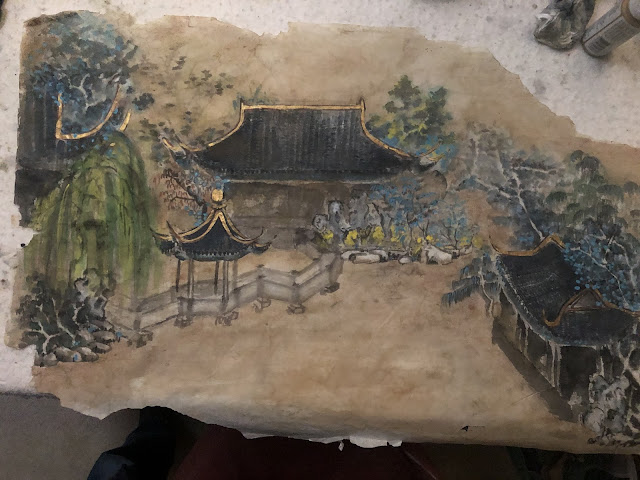As I was trying to repair my vintage record player I got to experience the joy of accomplishment, for having been able to make my turntable work for a little while. I also suffered the disappointment from defeat, having screwed around with something that was clearly beyond my expertise; rendering my turntable into a bipolar machine, inexplicably vacillating between 33 and 45 rpm while playing a record. I reflected on that experience and saw similarities in how some Chinese brush painting students failed. Often times knowing a little bit about a subject is more dangerous than being totally ignorant. Just because one could make a mark with a wet brush doesn't necessarily mean one knows to write or paint with a Chinese brush. The fact that I could solder and know which end of a capacitor is negative doesn't make me a electronics repairman.
I tried to nurse my nerves and took my mind off the anxiety in fixing the turntable by motivating myself to practice the fundamentals in Chinese brush painting. I picked orchid painting because of the close similarity between painting orchid and calligraphy. There shall be a day when I could be proud of my orchids, I consoled myself with platitude.
I was working on a parallel project in the mean time. I also had my eyes on an old landscape sketch that I had pinned to the plaster wall.
I was trying to depict a classical Chinese garden; a place that is rigidly structured, yet offers ample room for free contemplation and so much beauty. The sketch was done sometime ago and I had it pinned up so I could cast a wandering gaze at it from time to time, to see what needed to be worked on further. I do this religiously with almost all my works. I find such casual scrutiny beneficial and serendipitous.
Unfortunately the child in me led me to launch a drone in the room where I paint. The drone rose from the floor with the ushering of the joystick on the control tablet, but veered by itself sideways ( obviously some phantom force was involved, I couldn't be the person doing that !) into my pinned sketch. Well the exposed blades of the drone chopped up part of my sketch and tore it off the wall. I picked the carcass up from the floor and pinned it back on and it stayed there until now. I thought this would be an excellent opportunity to see if I could mend the painting, along with my turntable.
I was dividing my time between the orchid exercise and the garden restoration. Ink was the only color used for my orchid practice and the garden required an assortment of colors. I didn't want cross contamination of my ink dish with my color dishes.
I started by coloring my roofing and trees, to establish a mood. Well that wasn't exactly true. I was rehydrating the left over pigments in my color dishes, and they happened to be hues of green and indigo and vermillion. I was picking from left overs.
For some of the trees I used a blue hue for leaves, just to add a little variety.
I used a yellow underlayer of color on yet other trees, and on the willow.
When green was painted over the yellow undercoat, it presented a different hue, and the occasional yellow that came through added to the nuance of the palette.
I decided to jazz the painting up a little by giving it an aged and weathered look, with the help of burnt sienna.
The color wash and the travel of the brush tore off parts of the paper, since the propellers from my drone initiated the shredding some time ago.
I decided I was too timid with the burnt sienna, so I summoned tea stain mixed with ink, and more burnt sienna.
My weathered look scheme was coming alive.
After the wash had dried sufficiently, I decided the painting needed more adornment. I reached for the metallic gold acrylic from my tool chest and painted the hip roofs and the flying eaves golden.
The new attire bestowed a different personality to the painting. The metallic gold actually looked good over the vermillion undercoat. It had a persona of old relics or artifacts from temples
After I had a few days to ponder and ruminate on what I had done so far, I decided to accost more details to the painting. I decided some of the leaves on the trees could use a better definition. I also decided to make the plants behind the rocks in the middle of the painting more lucid, the juxtaposing of the Taihu stones rendered them obscure. I painted some bamboo leaves and gave them an ink outline, as I did selectively with some leaves at strategic positions in the painting.
Some will accuse me of succumbing to pedantry, indiscriminately bombarding the painting with fluffy details to conceal my less than perfect brushstrokes. My answer would be that until I was ready to be starkly naked, I would always dress up with something that complements my personality.
I reminded myself often, I do this for fun. In this particular case, I was trying to revive a sketch, executing parallel exercises between fixing my record player, practicing painting orchid and this.
In the end, I enjoyed all three events, a complete failure in electronics repair notwithstanding.
As the saying goes, it's all about the journey and not the destination.













































